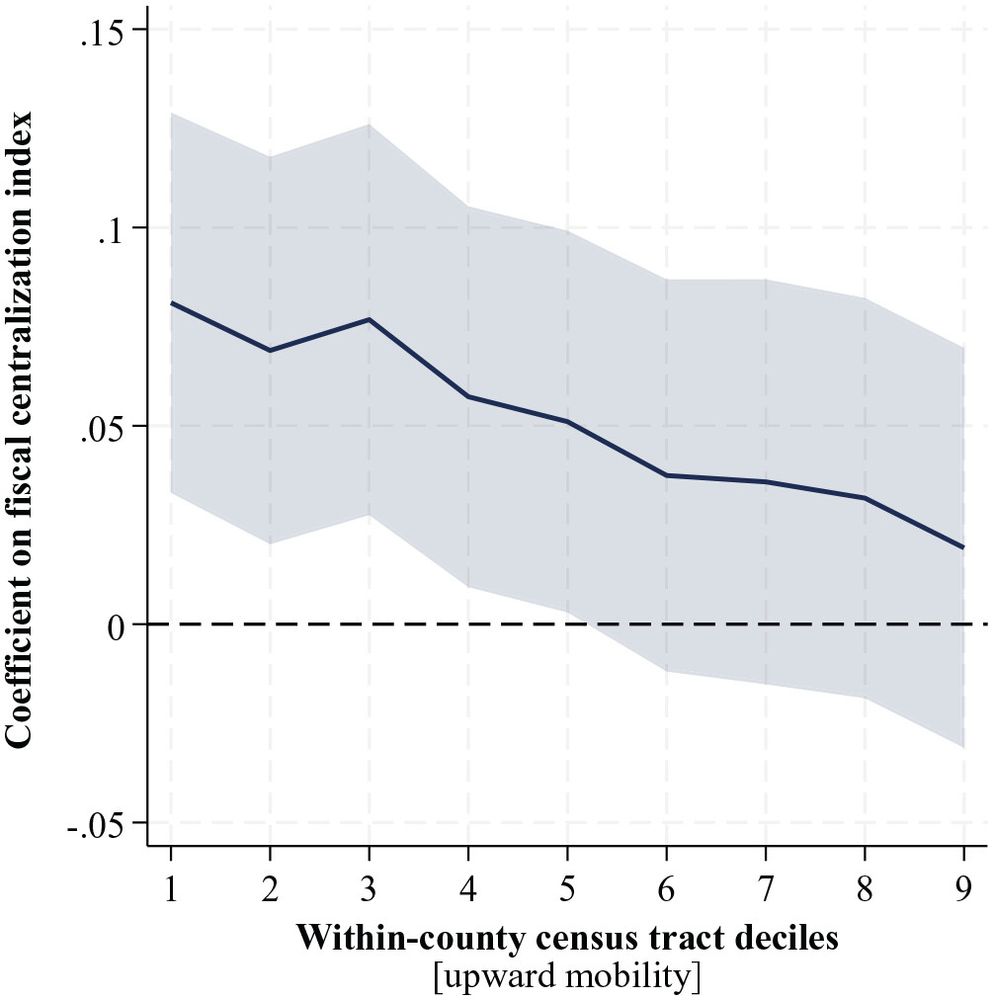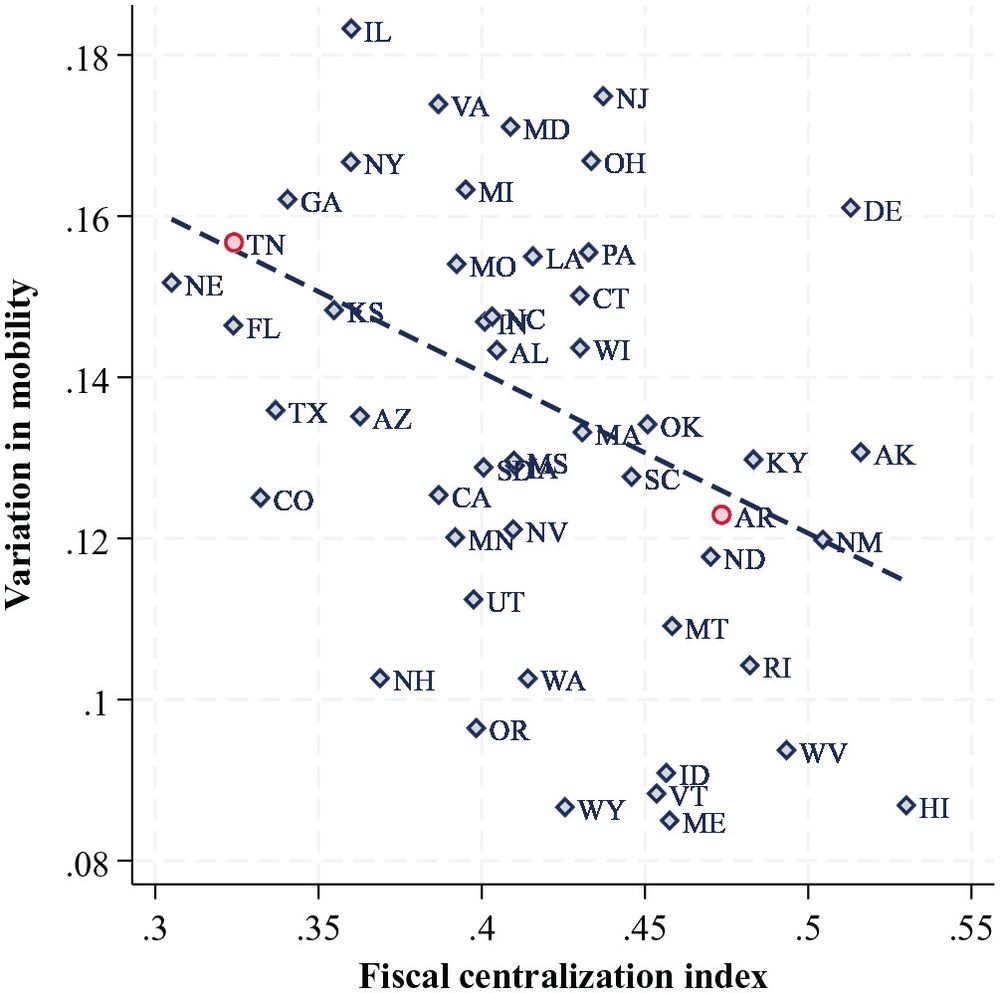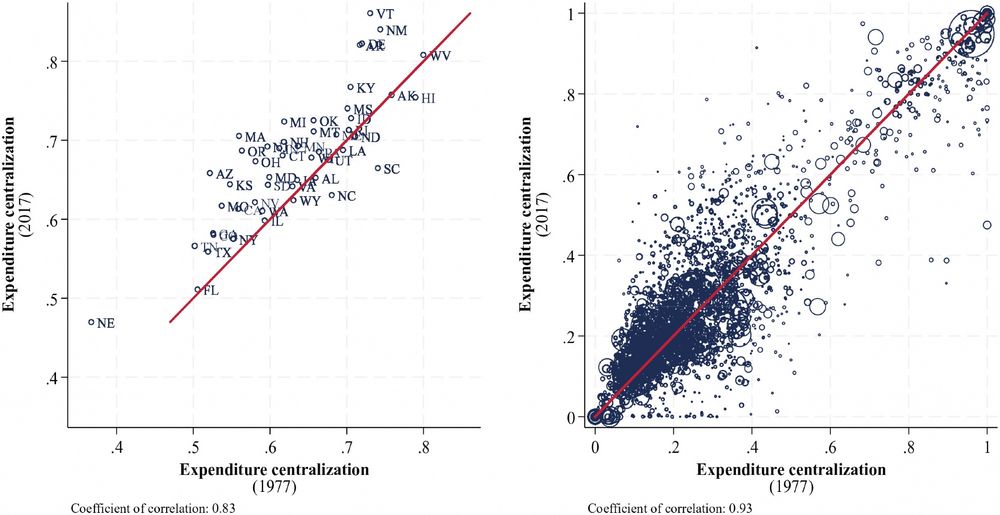Rourke O’Brien
@rourkeobrien.bsky.social
Associate Prof of Sociology @ Yale
public finance, economic mobility, household finance, health, demography, public policy
public finance, economic mobility, household finance, health, demography, public policy
Thanks Janet! 🙏
January 14, 2025 at 12:22 PM
Thanks Janet! 🙏
Sure! The estimate is small, esp net of covars; tho if there was a massive change to fiscal structure those measures (e.g., dispersion of HH poverty) would change as well.
Depends on spending LEVEL, too -- centralizing an area with low spending would do little to reduce spatial variation...
Depends on spending LEVEL, too -- centralizing an area with low spending would do little to reduce spatial variation...
January 10, 2025 at 4:32 PM
Sure! The estimate is small, esp net of covars; tho if there was a massive change to fiscal structure those measures (e.g., dispersion of HH poverty) would change as well.
Depends on spending LEVEL, too -- centralizing an area with low spending would do little to reduce spatial variation...
Depends on spending LEVEL, too -- centralizing an area with low spending would do little to reduce spatial variation...
thanks!! hope you are well!
January 9, 2025 at 6:57 PM
thanks!! hope you are well!
👋 yep: 1SD in FC index associated with 10% SD change in mobility COV (so 0.1 * .04)
January 9, 2025 at 6:30 PM
👋 yep: 1SD in FC index associated with 10% SD change in mobility COV (so 0.1 * .04)
Thanks, Frank! And...agreed!
January 7, 2025 at 4:45 PM
Thanks, Frank! And...agreed!
ah thank you Sasha, very kind! 🙏
January 7, 2025 at 4:23 PM
ah thank you Sasha, very kind! 🙏
Overall we argue that the 'fiscal structures' we inherit from the past are key to understanding contemporary variation in social outcomes.
Especially in the U.S. which has a remarkably complex system of public finance + unlike other federal countries, lacks a national fiscal equalization policy.
Especially in the U.S. which has a remarkably complex system of public finance + unlike other federal countries, lacks a national fiscal equalization policy.
January 7, 2025 at 4:17 PM
Overall we argue that the 'fiscal structures' we inherit from the past are key to understanding contemporary variation in social outcomes.
Especially in the U.S. which has a remarkably complex system of public finance + unlike other federal countries, lacks a national fiscal equalization policy.
Especially in the U.S. which has a remarkably complex system of public finance + unlike other federal countries, lacks a national fiscal equalization policy.
We go on to show that fiscal centralization reduces spatial inequality in mobility outcomes by "leveling up" the worst performing census tracts in a county.

January 7, 2025 at 4:17 PM
We go on to show that fiscal centralization reduces spatial inequality in mobility outcomes by "leveling up" the worst performing census tracts in a county.
We find there is indeed less place-based inequality in economic mobility outcomes in more centralized fiscal structures.
This association is apparent at both the state and local (county) levels.
This association is apparent at both the state and local (county) levels.


January 7, 2025 at 4:17 PM
We find there is indeed less place-based inequality in economic mobility outcomes in more centralized fiscal structures.
This association is apparent at both the state and local (county) levels.
This association is apparent at both the state and local (county) levels.
We use data from Opportunity Insights to estimate the degree of cross-census-tract inequality (variation) in the economic mobility outcomes of low-income (p25) children within each state and within each county.
We measure Fiscal Centralization for each state and each county using a novel index.
We measure Fiscal Centralization for each state and each county using a novel index.
January 7, 2025 at 4:17 PM
We use data from Opportunity Insights to estimate the degree of cross-census-tract inequality (variation) in the economic mobility outcomes of low-income (p25) children within each state and within each county.
We measure Fiscal Centralization for each state and each county using a novel index.
We measure Fiscal Centralization for each state and each county using a novel index.
In the study we hypothesize that more centralized fiscal structures will exhibit less spatial inequality (variation) in the economic mobility outcomes of low-income children.
Why? Many reasons. One: where government is more centralized, less variation in intensity of public sector across places.
Why? Many reasons. One: where government is more centralized, less variation in intensity of public sector across places.
January 7, 2025 at 4:17 PM
In the study we hypothesize that more centralized fiscal structures will exhibit less spatial inequality (variation) in the economic mobility outcomes of low-income children.
Why? Many reasons. One: where government is more centralized, less variation in intensity of public sector across places.
Why? Many reasons. One: where government is more centralized, less variation in intensity of public sector across places.
County area fiscal centralization is similarly sticky.
Here we show state and county centralization has changed little from 1977 to 2017, despite rise of inequality between households and between places.
Here we show state and county centralization has changed little from 1977 to 2017, despite rise of inequality between households and between places.

January 7, 2025 at 4:17 PM
County area fiscal centralization is similarly sticky.
Here we show state and county centralization has changed little from 1977 to 2017, despite rise of inequality between households and between places.
Here we show state and county centralization has changed little from 1977 to 2017, despite rise of inequality between households and between places.
Notice wide variation in the fiscal centralization of the 50 states - does not map on to contemporary differences in politics or sociodemographics or economies.
For example, stark difference in the centralization of neighboring states AR and TN we trace to origins in 18th & 19th century
For example, stark difference in the centralization of neighboring states AR and TN we trace to origins in 18th & 19th century

January 7, 2025 at 4:17 PM
Notice wide variation in the fiscal centralization of the 50 states - does not map on to contemporary differences in politics or sociodemographics or economies.
For example, stark difference in the centralization of neighboring states AR and TN we trace to origins in 18th & 19th century
For example, stark difference in the centralization of neighboring states AR and TN we trace to origins in 18th & 19th century
State fiscal centralization is the fraction of all fiscal action in a state performed by the state gov vs counties/cities/towns/districts.
County area fiscal centralization is the fraction of all fiscal action in a county area performed by the county government vs cities/towns/districts.
County area fiscal centralization is the fraction of all fiscal action in a county area performed by the county government vs cities/towns/districts.
January 7, 2025 at 4:17 PM
State fiscal centralization is the fraction of all fiscal action in a state performed by the state gov vs counties/cities/towns/districts.
County area fiscal centralization is the fraction of all fiscal action in a county area performed by the county government vs cities/towns/districts.
County area fiscal centralization is the fraction of all fiscal action in a county area performed by the county government vs cities/towns/districts.
Fiscal centralization captures the extent to which government action (spending, revenues, public employment) is located at the higher level of government.
Centralization of state and local fiscal structures is a byproduct of place-specific founding circumstances and path-dependent trajectories
Centralization of state and local fiscal structures is a byproduct of place-specific founding circumstances and path-dependent trajectories
January 7, 2025 at 4:17 PM
Fiscal centralization captures the extent to which government action (spending, revenues, public employment) is located at the higher level of government.
Centralization of state and local fiscal structures is a byproduct of place-specific founding circumstances and path-dependent trajectories
Centralization of state and local fiscal structures is a byproduct of place-specific founding circumstances and path-dependent trajectories
Prior research finds government spending to be a key driver of place-based differences in the economic mobility outcomes of low-income children.
In this study we ask, net of the spending level does the FISCAL CENTRALIZATION of state and local governments shape the spatial patterning of mobility?
In this study we ask, net of the spending level does the FISCAL CENTRALIZATION of state and local governments shape the spatial patterning of mobility?
January 7, 2025 at 4:17 PM
Prior research finds government spending to be a key driver of place-based differences in the economic mobility outcomes of low-income children.
In this study we ask, net of the spending level does the FISCAL CENTRALIZATION of state and local governments shape the spatial patterning of mobility?
In this study we ask, net of the spending level does the FISCAL CENTRALIZATION of state and local governments shape the spatial patterning of mobility?

